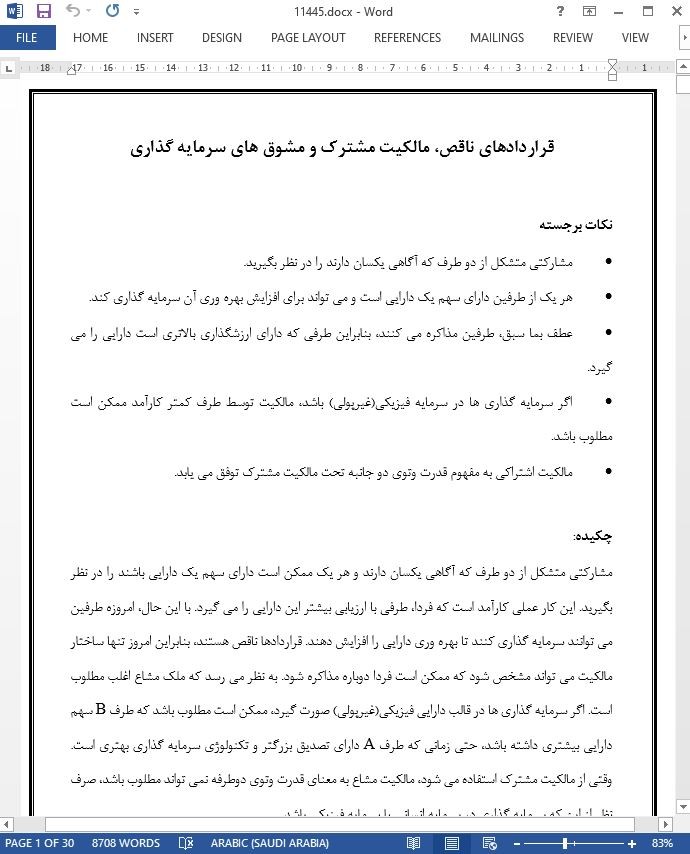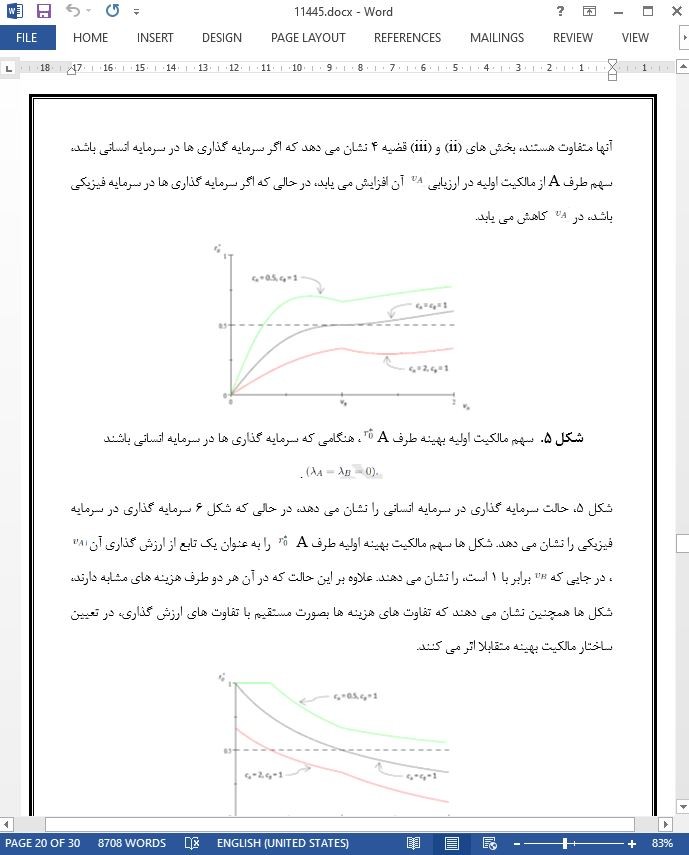
قراردادهای ناقص، مالکیت مشترک و مشوق های سرمایه گذاری
چکیده
مشارکتی متشکل از دو طرف که آگاهی یکسان دارند و هر یک ممکن است دارای سهم یک دارایی باشند را در نظر بگیرید. این کار عملی کارآمد است که فردا، طرفی با ارزیابی بیشتر این دارایی را می گیرد. با این حال، امروزه طرفین می توانند سرمایه گذاری کنند تا بهره وری دارایی را افزایش دهند. قراردادها ناقص هستند، بنابراین امروز تنها ساختار مالکیت می تواند مشخص شود که ممکن است فردا دوباره مذاکره شود. به نظر می رسد که ملک مشاع اغلب مطلوب است. اگر سرمایه گذاری ها در قالب دارایی فیزیکی(غیرپولی) صورت گیرد، ممکن است مطلوب باشد که طرف B سهم دارایی بیشتری داشته باشد، حتی زمانی که طرف A دارای تصدیق بزرگتر و تکنولوژی سرمایه گذاری بهتری است. وقتی از مالکیت مشترک استفاده می شود، مالکیت مشاع به معنای قدرت وتوی دوطرفه نمی تواند مطلوب باشد، صرف نظر از این که سرمایه گذاری در سرمایه انسانی یا سرمایه فیزیکی باشد.
1- معرفی
مشارکتی متشکل از دو طرف با ریسک خنثی را در نظر بگیرید که هرکدام از آنها سهم دارایی را دارند که می تواند فردا معامله شود. واضح است که این امر بواقع کارآمد است که طرف با ارزیابی بیشتر این دارایی، فردا 100 درصد از دارایی را دریافت خواهد کرد. با این حال، فرض کنید که امروز طرفین می توانند سرمایه گذاری های غیر ادغام پذیر را به منظور افزایش بهره وری دارایی انجام دهند. ما تحلیل می کنیم که در ابتدا چه کسی باید صاحب دارایی شود، با توجه به این که مذاکرات فردا میان طرفینِ بطور یکسان آگاه، به واقع در تخصیص مالکیت موثر خواهد بود..
7- نتیجه گیری
این مقاله چشم انداز قراردادهای ناقص مربوط به ملک مشاع و مسئله انحلال مشارکت تضامنی را ارائه می دهد. با توجه به رویکرد حقوق مالکیت تا تئوری شرکت، اگر تنها مالکیت انحصاری امکان پذیر باشد و طرفین هم ارزیابی یکسانی از دارایی داشته باشند، طرف با تکنولوژی سرمایه گذاری بهتر (یعنی طرف با هزینه های سرمایه گذاری کمتر) باید صاحب اولیه باشد. با این حال، زمانی که ارزیابی های طرفین متفاوت باشد، ساختار مالکیت مطلوب به شدت به ماهیت سرمایه گذاری بستگی دارد. به طور خاص، ما متوجه شده ایم که زمانی که سرمایه گذاری ها در سرمایه فیزیکی است، اگر تنها مالکیت انحصاری ممکن باشد، طرف با ارزیابی کوچکتر باید مالک اولیه باشد. علاوه بر این، مطابق با نوشتجات انحلال مشارکت تضامنی، ما دریافتیم که ملک مشاع (که معمولا در نوشتجات حقوق مالکیت نادیده گرفته می شود) اغلب بهینه است. با این حال، دلیل بهینه بودن ملک مشاع متفاوت است. تا کنون، نوشتجات انحلال مشارکت تضامنی نگرانِ دست یافتن به کارایی عملی تحت اطلاعات نامتقارن بود، در حالیکه ما در عوض، روی تدارک انگیزه های سرمایه گذاری در یک چارچوب قرارداد بندی ناقص با اطلاعات متقارن تمرکز کردیم. علاوه بر این، ما نشان داده ایم که حتی زمانی که سرمایه گذاری ها(به طور کامل یا به طور جزئی) در سرمایه فیزیکی هستند، مالکیت مشترک به معنای حق وتوی دو جانبه هرگز بهینه نیست. از این رو، تا آنجا که حق وتوی دو جانبه در عمل مشاهده می شود، توضیحات دیگر مانند اطلاعات نامتقارن مورد نیاز هستند.
Abstract
Consider a partnership consisting of two symmetrically informed parties who may each own a share of an asset. It is ex post efficient that tomorrow the party with the larger valuation gets the asset. Yet, today the parties can make investments to enhance the asset's productivity. Contracts are incomplete, so today only the ownership structure can be specified, which may be renegotiated tomorrow. It turns out that shared ownership is often optimal. If the investments are embodied in the physical asset, it may be optimal that party B has a larger ownership share even when party A has a larger valuation and a better investment technology. When shared ownership is taken into account, joint ownership in the sense of bilateral veto power cannot be optimal, regardless of whether the investments are in human capital or in physical capital.
1 Introduction
Consider a partnership consisting of two risk-neutral parties each of whom owns a share of an asset that can be traded tomorrow. Clearly, it is ex post efficient that the party with the larger valuation of the asset will get 100 percent of the asset tomorrow. Yet, suppose that today the parties can make non-contractible investments in order to enhance the productivity of the asset. We analyze who should initially own the asset, given that tomorrow negotiations between the symmetrically informed parties will result in the ex post efficient ownership allocation.
7 Conclusion
This paper provides an incomplete contracts perspective on shared ownership and the partnership dissolution problem. In line with the established property rights approach to the theory of the firm, the party with the better investment technology (i.e., the party with smaller investment costs) should be the initial owner if only sole ownership is feasible and the parties have the same valuation for the asset. However, when the parties’ valuations differ, then the optimal ownership structure crucially depends on the nature of investments. In particular, we have found that when the investments are in physical capital, then the party with the smaller valuation should be the initial owner if only sole ownership is possible. Moreover, in line with the partnership dissolution literature, we have found that shared ownership (which is usually neglected in the property rights literature) is often optimal. Yet, the reason for the optimality of shared ownership is different. So far, the partnership dissolution literature was concerned with achieving ex post efficiency under asymmetric information, while we have instead focused on the provision of investment incentives in an incomplete contracting framework with symmetric information. Furthermore, we have shown that even when investments are (fully or partially) in physical capital, joint ownership in the sense of bilateral veto power is never optimal. Hence, to the extent that bilateral veto power is observed in practice, other explanations such as asymmetric information are required.
نکات برجسته
چکیده
1- معرفی
2- مدل
3- بهترین راه حل دوم
4- مالکیت A در مقابل مالکیت B
5- مالکیت مشترک
6- مالکیت مشترک (Joint ownership) در مقابل ملک مشاع (shared ownership)
7- نتیجه گیری
Highlights
Abstract
1 Introduction
2 The model
3 The second-best solution
4 A-ownership versus B-ownership
5 Shared Ownership
6 Joint ownership vs. shared ownership
7 Conclusion
- ترجمه فارسی مقاله با فرمت ورد (word) با قابلیت ویرایش، بدون آرم سایت ای ترجمه
- ترجمه فارسی مقاله با فرمت pdf، بدون آرم سایت ای ترجمه



